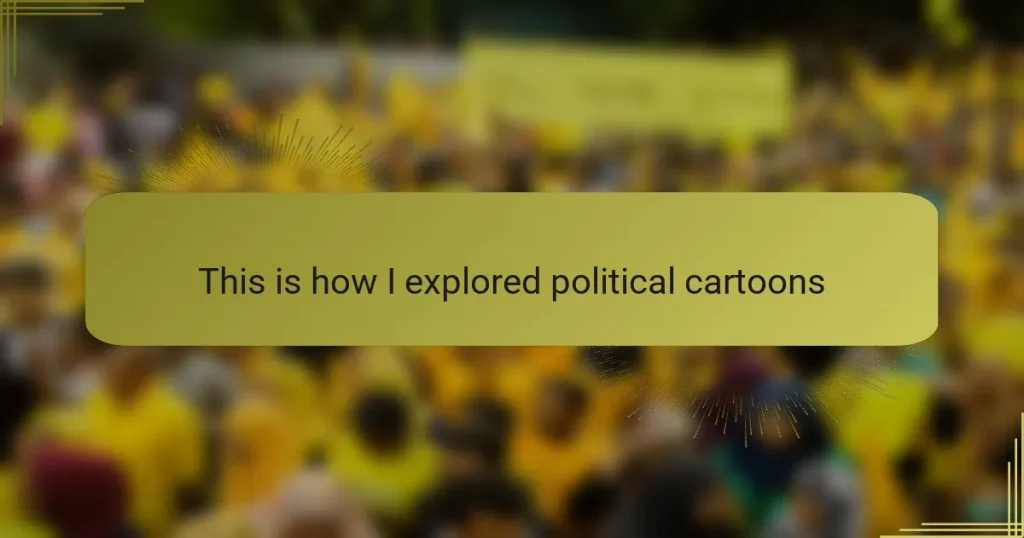Key takeaways
- Political satire awards recognize the creativity and impact of cartoonists, promoting public discourse and bold artistic expression.
- Political cartoons simplify complex issues, stimulate emotional engagement, and serve as critical social commentary that inspires conversations.
- Major awards in political cartooning, like the Pulitzer Prize and Herblock Prize, acknowledge excellence and highlight the role of cartoons in influencing society.
- Key evaluation criteria for awards include clarity of message, wit, originality, and artistic technique, ensuring impactful political commentary.
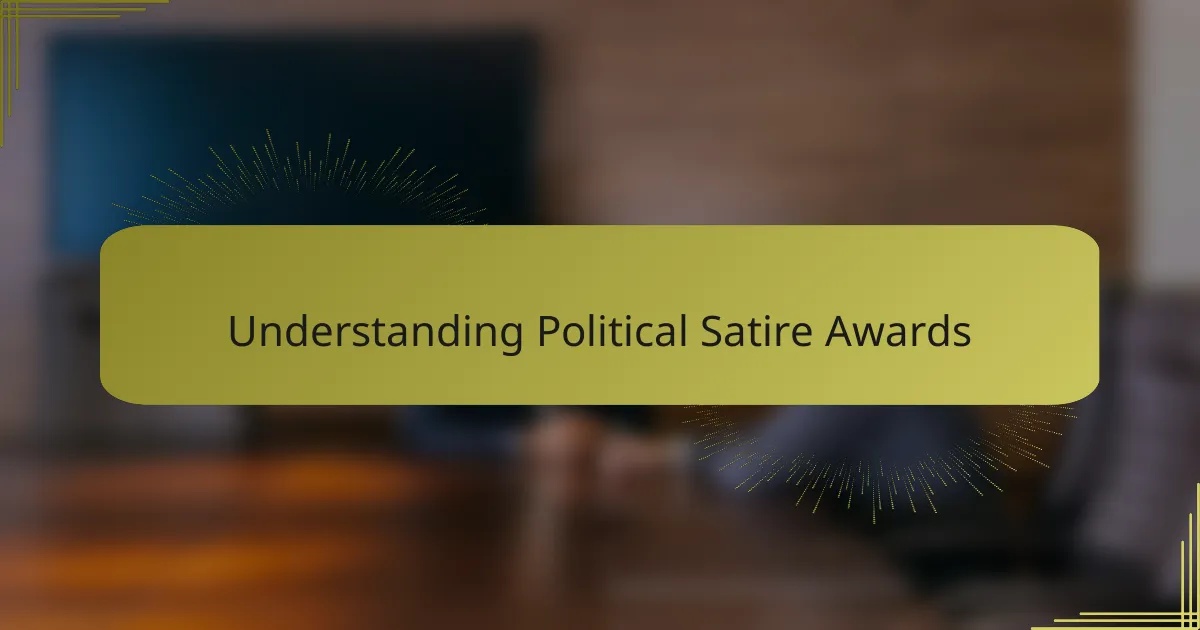
Understanding Political Satire Awards
Political satire awards celebrate the cleverness and creativity behind cartoonists who hold a mirror to society. I remember the first time I encountered a political cartoon that made me chuckle while simultaneously prompting me to reflect on a serious issue. It was a poignant reminder of how humor can be a vehicle for change and understanding, and how these awards honor that powerful blend of wit and insight.
Award-winning political cartoons often encapsulate complex issues within a single frame, striking a perfect balance between humor and critique. They encourage us to think critically and engage with current affairs in a way that’s both entertaining and thought-provoking. Here are some key aspects that make these awards significant:
- Recognition of creativity and craft in conveying political commentary
- Encouragement for artists to take risks and express bold viewpoints
- Promotion of public discourse about important societal issues
- The role of humor in making difficult subjects more accessible
- Celebration of diverse perspectives and artistic styles in political expression

Importance of Political Cartoons
Political cartoons hold significant importance in the realm of political discourse. They distill complex issues into visual commentary, making them accessible and engaging for a broad audience. I remember the first time a cartoon helped me grasp an intricate political situation that words alone couldn’t convey; it was enlightening to see these themes represented artistically.
Moreover, they serve as a powerful form of social critique, often stirring emotions like humor, outrage, or reflection. I’ve noticed that a single cartoon can spark conversations among friends or family, prompting discussions that go far beyond the image itself.
Here’s a comparison of different aspects of political cartoons:
| Aspect | Impact |
|---|---|
| Simplification of Ideas | Makes complex issues digestible |
| Emotional Engagement | Evokes a range of feelings and reactions |
| Social Critique | Challenges the status quo and provokes thought |
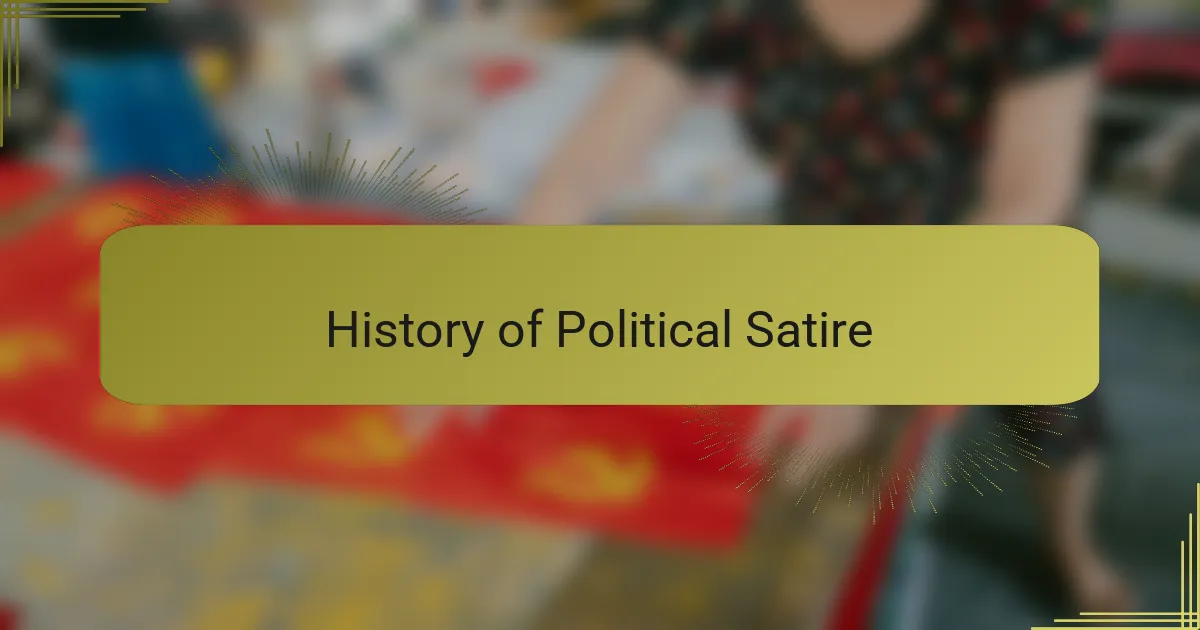
History of Political Satire
Political satire has a rich and fascinating history, dating back centuries. I find it intriguing how satirical cartoons have evolved alongside political movements and social changes. For instance, during the American Revolution, cartoons served not just as entertainment but also as powerful tools for political commentary and persuasion, engaging the public in critical discussions about governance and liberty.
One of my favorite examples is James Gillray, a British caricaturist from the late 18th century. His work often skewered political figures and illuminated the absurdities of his time. I remember feeling a sense of empowerment when I first saw his caricatures—they provided a way for ordinary people to connect with the political events that seemed so distant.
Fast forward to today, and political cartoons still resonate, often capturing a moment or sentiment in just a single image. They invite laughter while encouraging thought, proving that humor can be a strong vehicle for discourse.
| Era | Key Characteristics |
|---|---|
| 18th Century | Use of caricature to critique political leaders; blend of humor and serious commentary. |
| 20th Century | Incorporation of modern events; rise of editorial cartoons in newspapers; diversification in style and medium. |
| 21st Century | Digital platforms for wider reach; use of social media; quick satirical responses to current events. |
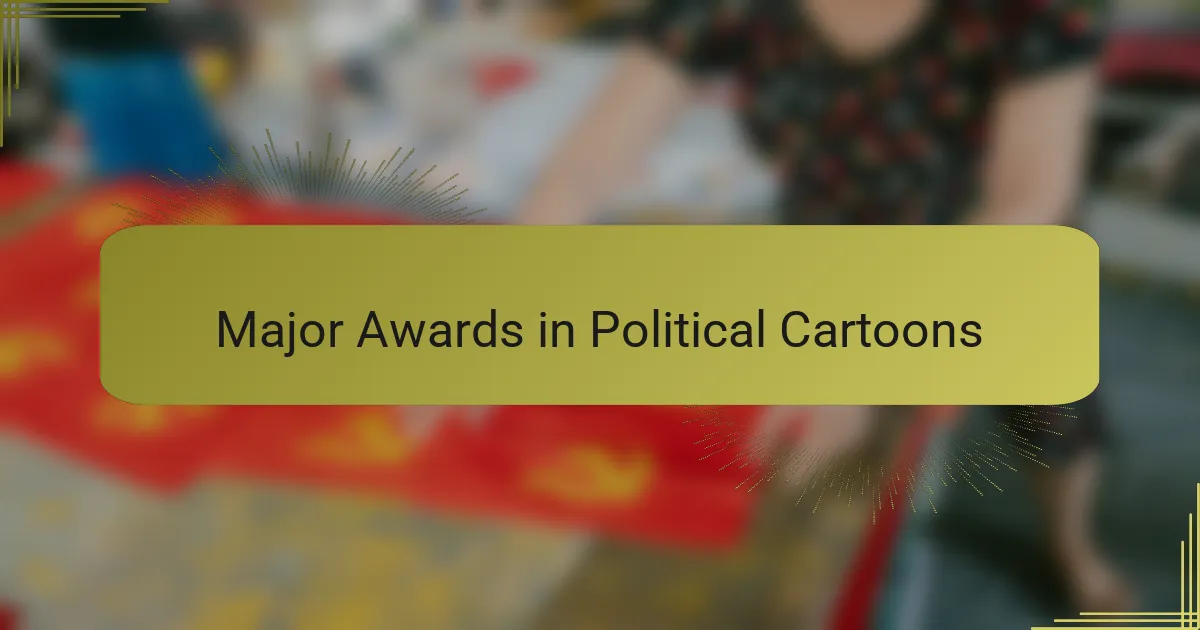
Major Awards in Political Cartoons
When exploring the world of political cartoons, I quickly realized that recognition through awards plays a significant role in highlighting exceptional work. The accolades celebrate creativity and the sharp wit that cartoonists infuse into their art. I remember the excitement I felt when I discovered the Pulitzer Prize for Editorial Cartooning; it was inspiring to see how this prestigious award honors those who skillfully blend humor with insight into current events.
Several major awards stand out in the realm of political cartoons, each celebrating unique aspects of this art form:
- Pulitzer Prize for Editorial Cartooning: Awarded annually, this prestigious prize recognizes the best feature in editorial cartooning.
- Herblock Prize: Named after the legendary cartoonist Herb Block, this award honors cartoons that exemplify excellence and social commentary.
- National Cartoonists Society Awards: These awards provide various categories, including political cartoons, appreciating the broader cartooning community.
- Robert F. Kennedy Journalism Award: This award highlights cartoonists who engage in social justice issues, emphasizing the impact of cartooning beyond humor.
- The George Polk Awards: Known for recognizing courageous journalism, these awards sometimes spotlight innovative political cartoons that challenge authority.
Each award not only celebrates talent but also demonstrates the power of cartoons to influence public discourse.
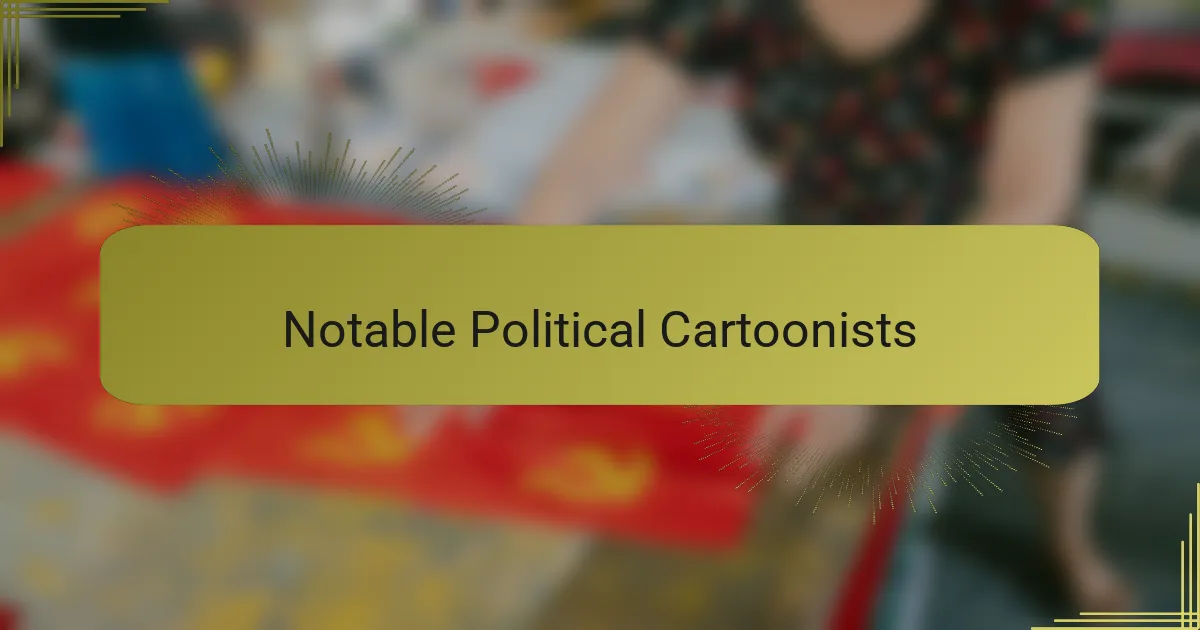
Notable Political Cartoonists
One of the most notable figures in political cartooning is David Horsey, whose work often encapsulates the essence of contemporary American politics with both humor and poignancy. I still recall the first cartoon I saw from him, featuring a witty portrayal of a political debate. It struck me how effectively he could bring complex issues to the forefront while making me chuckle—a true testament to his skill as a cartoonist.
Then there’s the late Herb Block, known affectionately as “Herb,” whose sharp observations and distinctive style earned him the Pulitzer Prize for Editorial Cartooning. I find it fascinating how his work resonated through decades, capturing the pulse of American society and government. Looking at his cartoons, I sometimes wonder what he would have to say about today’s political landscape, given his uncanny ability to distill urgent messages into striking visuals.
Another great is Pat Oliphant, whose bold and often exaggerated caricatures challenged authority and provided social commentary that made me reflect deeply. His cartoons were not merely designs; they were calls to action. I couldn’t help but feel a mix of admiration and inspiration while viewing his pieces, reminding me of how essential these artists are to our understanding of political madness. Who wouldn’t feel compelled to examine their beliefs after encountering such impactful artwork?

Criteria for Political Cartoon Awards
When it comes to political cartoon awards, the evaluation criteria are fascinating. I’ve found that clarity of message is crucial; a great cartoon conveys its theme instantly. Wit and humor also play significant roles; after all, satire is about making a poignant commentary while engaging the audience.
Another aspect that stands out is the originality of the satirical take. In my experience, awards often go to cartoons that present unique perspectives on current events. The artist’s technique and style also matter; visually striking cartoons catch the eye and linger in the mind, making their message even more impactful.
Here’s a comparison table of key criteria that are often utilized in the evaluation process for political cartoon awards:
| Criteria | Description |
|---|---|
| Clarity of Message | Instantly communicates the theme or idea. |
| Wit and Humor | Engages the audience while providing insightful commentary. |
| Originality | Presents unique perspectives on current events. |
| Artistic Technique | Visual style enhances the overall impact of the cartoon. |
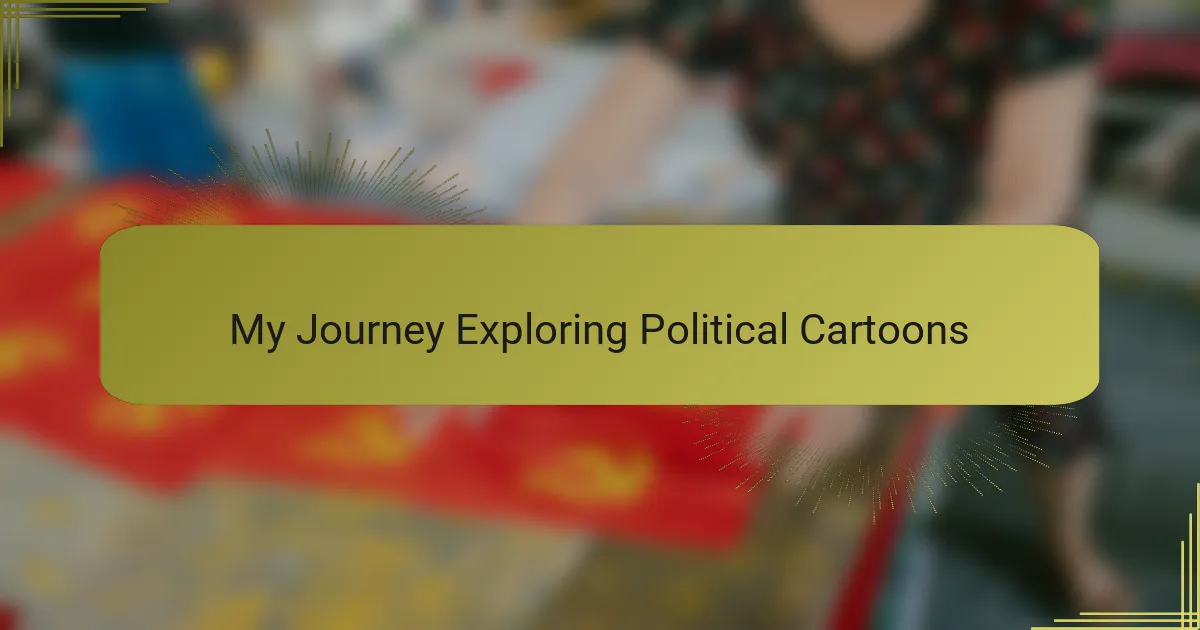
My Journey Exploring Political Cartoons
Understanding the nuances of political cartoons has truly been an enlightening journey for me. I recall my first encounter with a cartoon that brilliantly captured the absurdity of a political event, leaving me laughing and thinking at the same time. It made me wonder, how can a simple drawing provoke such deep thought while entertaining?
As I delved deeper, I became fascinated by the artists’ ability to compress complicated political narratives into just a few frames. I remember poring over collections of cartoons, each one telling a different story—sometimes light-hearted, sometimes biting. It struck me how these illustrations can essentially educate us about policy issues or social injustices without overwhelming the viewer with text.
Through this exploration, I’ve developed a genuine appreciation for the craft of political cartooning and the mindset required to create impactful work. I often find myself asking: What drives an artist to take risks with their message? For me, it’s the boldness and creativity that captivatingly intertwines humor and commentary, challenging our perceptions and sparking important conversations.
